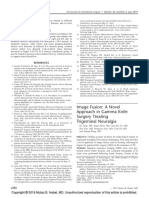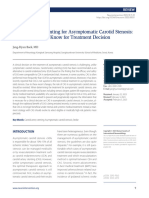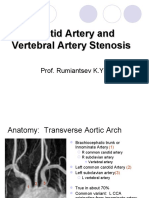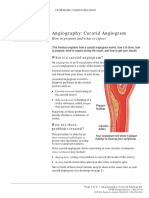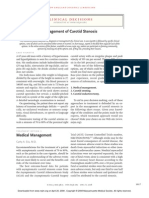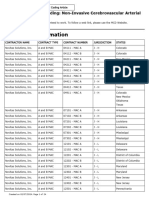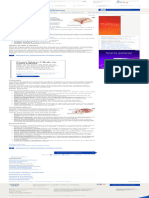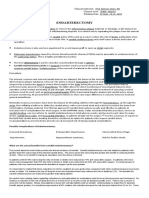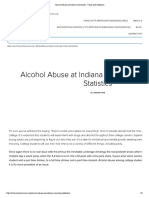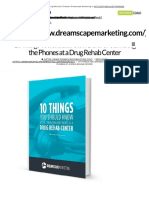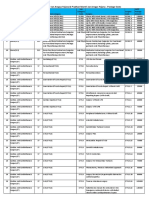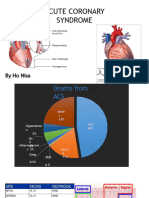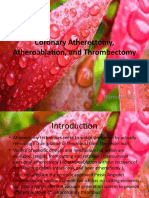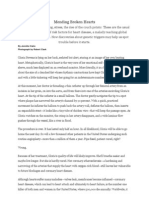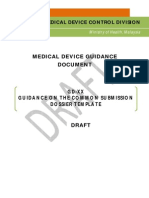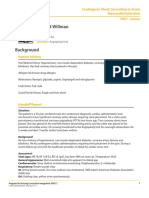Sample High Risk Letter Medical Necessity
Uploaded by
JasonSample High Risk Letter Medical Necessity
Uploaded by
JasonPhysician Note: This sample letter template provides suggestions to assist in writing a Letter of
Medical Necessity or prior authorization request for the Acculink™ Carotid Artery Stent System or the
Xact™ Carotid Stent System for patients with carotid artery disease at high surgical risk. It is always the
provider’s responsibility to determine the medical necessity of a service for a patient and payer
requirements which vary by payer. This sample letter is not meant to be used as a formal letter.
Physicians should customize the letter based on the patient’s actual medical history, diagnosis and
consistent with any specific payer requirements. It is very important to ensure all information provided
to payers is accurate and medical necessity of the procedure is reflected in the patient’s medical record.
Sample Letter of Medical Necessity
Carotid Artery Stenting – High Surgical Risk Patients
Instructions for completing the sample letter of medical necessity:
1. Please customize the medical necessity letter template based on the medical appropriateness of carotid artery
stenting for your patient. Fields required for customization are highlighted in yellow.
2. It is important to provide the most complete information to assist with the prior authorization process.
3. After you have customized the medical necessity letter, please make sure to delete any specific instructions for
completion that are highlighted throughout the letter, so the health plan does not misinterpret the information.
Disclaimer
This document and the information contained herein is for general information purposes only and is not intended, and does not
constitute, legal, reimbursement, business, clinical, or other advice. Furthermore, it is not intended to and does not constitute a
representation or guarantee of reimbursement, payment, or charge, or that reimbursement or other payment will be received. It
is not intended to increase or maximize payment by any payer. Similarly, nothing in this document should be viewed as
instructions for selecting any particular code, and Abbott does not advocate or warrant the appropriateness of the use of any
particular code. The ultimate responsibility for coding and obtaining payment/reimbursement remains with the customer. This
includes the responsibility for accuracy and veracity of all coding and claims submitted to third-party payers. In addition, the
customer should note that laws, regulations, and coverage policies are complex and are updated frequently, and, therefore, the
customer should check with its local carriers or intermediaries often and should consult with legal counsel or a financial, coding,
or reimbursement specialist for any questions related to coding, billing, reimbursement or any related issues. This update
reproduces information for reference purposes only. It is not provided or authorized for marketing use.
Abbott Product Information
Any questions or comments about Abbott products or codes and Medicare policies that may be applicable to Abbott products
should be directed to the Abbott Vascular Reimbursement Hotline (1-800-354-9997). Product information including FDA
approved or cleared indications for Abbott Vascular products is provided in accordance with Abbott policies and FDA.
Information contained herein for DISTRIBUTION in U.S. ONLY.
See Important Safety Information referenced within. Page 1 of 12
©2022 Abbott. All rights reserved. MAT-2007489 v3.0
Date
Health Plan
Address
City/State/Zip
Attention: Medical Director
Member Name: ______________________________ Member ID# _____________________
DX(s) ______________________________________________________________________
Physician ________________________________ Facility ____________________________
Planned Date of Service _______________________________________
I am writing on behalf of my patient, __________________________, to request prior authorization for
treatment of carotid artery disease with carotid angioplasty and stenting with embolic protection (CPT ‡ code 37215).
The Rapid Exchange (RX) Acculink™ Carotid Stent System was approved in August 2004 and Xact™ Carotid Stent
System was approved in September 2005 for patients with carotid artery stenosis at high surgical risk. More
detailed information on the labeled indication is provided below.
The RX Acculink™ Carotid Stent System, used in conjunction with the Abbott Vascular embolic protection system
specified below, is indicated for the treatment of patients at high and standard risk for adverse events from carotid
endarterectomy who require carotid revascularization and meet the criteria outlined below:
High Surgical Risk Standard Surgical Risk
Symptomatic Status
(Acculink™Approval Aug. 2004) (Acculink™ Approval May 2011)
Embolic Protection
Abbott Vascular’s Accunet or Emboshield Family
System
≥ 70% stenosis of the common or internal
With neurological ≥ 50% stenosis of the common or internal carotid carotid artery by ultrasound or ≥ 50% stenosis
symptoms artery by ultrasound or angiogram of the common or internal carotid artery by
angiogram
≥ 70% stenosis of the common or internal
Without neurological ≥ 80% stenosis of the common or internal carotid carotid artery by ultrasound or ≥ 60% stenosis
symptoms artery by ultrasound or angiogram of the common or internal carotid artery by
angiogram
Reference vessel
Must be within 4.0 mm – 9.0 mm at the target lesion
diameter
The Xact™ Carotid Stent System (Xact™), used in conjunction with the Emboshield Embolic Protection System is
indicated for the improvement of the lumen diameter of carotid arteries in patients considered at high risk for
adverse events from carotid endarterectomy who require percutaneous carotid angioplasty and stenting for
occlusive artery disease and meet the criteria outlined below:
Patients with carotid artery stenosis (≥ 50% for symptomatic patients by ultrasound or angiography or ≥ 80% for
asymptomatic patients by ultrasound or angiography), located between the origin of the common carotid artery and
the intra-cranial segment of the internal carotid artery AND Patients must have a reference vessel diameter ranging
between 4.8 mm and 9.1 mm at the target lesion.
Clinical History
[My patient is an XX year old [insert gender] who has [insert detailed diagnostic description and ICD-10 diagnosis
codes]. Insert other relevant patient clinical information here, including diagnostic work-up studies and results,
anatomical location of the stenosis, percent stenosis, and if symptomatic.]
Treatment Rationale
Carotid artery disease accounts for 20% of ischemic strokes.1, 2, 3 Revascularization for carotid artery disease has
been shown to prevent stroke and reduce death rate in multiple randomized trials. 3,4,5 Carotid artery stenting as a
method for revascularization is less invasive than surgery. It is recommended as a treatment option by the 2011
National practice guidelines, which is endorsed by all relevant medical specialties. 3 Two pivotal trials support the
Information contained herein for DISTRIBUTION in U.S. ONLY.
See Important Safety Information referenced within. Page 2 of 12
©2022 Abbott. All rights reserved. MAT-2007489 v3.0
use of carotid artery stenting as a treatment option - the Carotid Revascularization Endarterectomy versus Stenting
Trials (CREST) and the Asymptomatic Carotid Trial (ACT-I).
CREST is a major NIH-sponsored randomized clinical trial comparing the safety and effectiveness of carotid artery
stenting and carotid endarterectomy in 2,502 symptomatic and asymptomatic standard surgical risk patients. The
10-year results of CREST, published in the New England Journal of Medicine, showed long-term results
demonstrating that carotid artery stenting with the Acculink™ Carotid Stent System and Accunet™ Embolic
Protection System was safe and effective in treating carotid artery disease for standard surgical risk patients and
provided long-term durable outcomes to prevent stoke during the postprocedural period.6
ACT-I is an Abbott sponsored randomized controlled clinical trial comparing the safety and effectiveness of carotid
artery stenting and carotid endarterectomy in 1,453 asymptomatic, standard surgical risk patients. The 5-year
results of the ACT-I analysis, published in the New England Journal of Medicine, showed long-term results
demonstrating that carotid artery stenting with the Xact™ Carotid Stent System and Emboshield NAV 6™ Embolic
Protection System was safe and effective when treating carotid artery disease for standard surgical risk patients and
provided long-term durable outcomes to prevent stroke during the postprocedural period. 7
Patients indicated for carotid artery stenting who are at high risk for surgery have no other interventional options.
Data from multiple other pivotal clinical trials and post-market studies (ARCHeR, SECuRITY, CAPTURE,
CAPTURE 2, EXACT, and PROTECT) demonstrate the safety and effectiveness of carotid stenting in high surgical
risk patients.8, 9, 10, 11, 12, 13, 14, 15, 16 Since the FDA approval trials, event rates (death, stroke, and MI) in high surgical risk
patients have improved and are consistent with AHA guidelines set for symptomatic and asymptomatic lesions. A
decrease in periprocedural event rates is due to advancement in technology, increasing operator experience, and
better patient selection.
Written authorization should be faxed to ____________________. If you have any questions please do not
hesitate to contact me.
Sincerely,
Physician Name, Title, and Institution
Please refer to the Reference section for all articles cited within this letter.
Information contained herein for DISTRIBUTION in U.S. ONLY.
See Important Safety Information referenced within. Page 3 of 12
©2022 Abbott. All rights reserved. MAT-2007489 v3.0
References
1. Lloyd-Jones D, Adams RJ, et al. Heart disease and stroke statistics – 2010 update: A report from the
American Heart Association. Circulation. 2010;121(7):948-54.
2. White H, Boden-Albala B, Wang C, et al. Ischemic stroke subtype incidence among whites, blacks, and
Hispanics: The Northern Manhattan Study. Circulation. 2005;111(10):1327-31.
3. Brott TG, et al. 2011 ASA/ACCF/AHA/AANN/AANS/ACR/ASNR/CNS/SAIP/SCAI/SIR/SNIS/SVM/SVS
guideline on the management of patients with extracranial carotid and vertebral artery disease: executive
summary. A report of the American College of Cardiology Foundation/American Heart Association Task
Force on Practice Guidelines, and the American Stroke Association, American Association of Neuroscience
Nurses, American Association of Neurological Surgeons, American College of Radiology, American Society
of Neuroradiology, Congress of Neurological Surgeons, Society of Atherosclerosis Imaging and Prevention,
Society for Cardiovascular Angiography and Interventions, Society of Interventional Radiology, Society of
NeuroInterventional Surgery, Society for Vascular Medicine, and Society for Vascular Surgery. Circulation.
2011;124(4):489-532.
4. Chaturvedi S, Bruno A, Feasby T, et al. Carotid endarterectomy--an evidence-based review: report of the
Therapeutics and Technology Assessment Subcommittee of the American Academy of Neurology.
Neurology. 2005;65(6):794-801.
5. Halliday A, Mansfield A, Marro J, et al. Prevention of disabling and fatal strokes by successful carotid
endarterectomy in patients without recent neurological symptoms: randomised controlled trial [published
correction appears in Lancet. 2004 Jul 31;364(9432):416]. Lancet. 2004;363(9420):1491-1502.
6. Brott TG, Howard G, Roubin GS, et al. Long-Term Results of Stenting versus Endarterectomy for Carotid-
Artery Stenosis. N Engl J Med. 2016;374(11):1021-1031.
7. Rosenfield K, Matsumura JS, Chaturvedi S, et al. Randomized Trial of Stent versus Surgery for
Asymptomatic Carotid Stenosis. N Engl J Med. 2016;374(11):1011-1020.
8. Gray WA, Hopkins LN, Yadav S, et al. Protected carotid stenting in high-surgical-risk patients: the ARCHeR
results [published correction appears in J Vasc Surg. 2007 Jan;45(1):226]. J Vasc Surg. 2006;44(2):258-
268.
9. Gray WA, Yadav JS, Verta P, et al. The CAPTURE registry: results of carotid stenting with embolic
protection in the post approval setting. Catheter Cardiovasc Interv. 2007;69(3):341-348.
10. Fairman R, Gray WA, Scicli AP, et al. The CAPTURE registry: analysis of strokes resulting from carotid
artery stenting in the post approval setting: timing, location, severity, and type. Ann Surg.
2007;246(4):551-558.
11. Gray WA, Yadav JS, Verta P, et al. The CAPTURE registry: predictors of outcomes in carotid artery stenting
with embolic protection for high surgical risk patients in the early post-approval setting. Catheter
Cardiovasc Interv. 2007;70(7):1025-1033.
12. Gray WA, Chaturvedi S, Verta P; Investigators and the Executive Committees. Thirty-day outcomes for
carotid artery stenting in 6320 patients from 2 prospective, multicenter, high-surgical-risk registries. Circ
Cardiovasc Interv. 2009;2(3):159-166.
13. Chaturvedi S, Matsumura JS, Gray W, Xu C, Verta P; CAPTURE 2 Investigators and Executive Committee.
Carotid artery stenting in octogenarians: periprocedural stroke risk predictor analysis from the multicenter
Carotid ACCULINK/ACCUNET Post Approval Trial to Uncover Rare Events (CAPTURE 2) clinical trial.
Stroke. 2010;41(4):757-764.
14. Matsumura JS, Gray W, Chaturvedi S, et al. CAPTURE 2 risk-adjusted stroke outcome benchmarks for
carotid artery stenting with distal embolic protection. J Vasc Surg. 2010;52(3):576-583.
15. Gray WA, Rosenfield KA, Jaff MR, et al. Influence of site and operator characteristics on carotid artery stent
outcomes: analysis of the CAPTURE 2 (Carotid ACCULINK/ACCUNET Post Approval Trial to Uncover
Rare Events) clinical study. JACC Cardiovasc Interv. 2011;4(2):235-246.
16. Matsumura JS, Gray W, Chaturvedi S, Yamanouchi D, Peng L, Verta P. Results of carotid artery stenting
with distal embolic protection with improved systems: Protected Carotid Artery Stenting in Patients at High
Risk for Carotid Endarterectomy (PROTECT) trial. J Vasc Surg. 2012;55(4):968-976.e5.
Information contained herein for DISTRIBUTION in U.S. ONLY.
See Important Safety Information referenced within. Page 4 of 12
©2022 Abbott. All rights reserved. MAT-2007489 v3.0
IMPORTANT SAFETY INFORMATION
RX AcculinkTM
Carotid Stent System
INDICATIONS
The RX Acculink™ Carotid Stent System, used in conjunction with the Abbott Vascular embolic protection system specified
below, is indicated for the treatment of patients at high and standard risk for adverse events from carotid endarterectomy who
require carotid revascularization and meet the criteria outlined below:
High Risk Standard Risk
Embolic Protection System Abbott Vascular’s Accunet or Emboshield Family
With neurological symptoms ≥ 50% stenosis of the common or ≥ 70% stenosis of the common or internal carotid artery
internal carotid artery by ultrasound by ultrasound or ≥ 50% stenosis of the common or
or angiogram internal carotid artery by angiogram
Without neurological symptoms ≥ 80% stenosis of the common or ≥ 70% stenosis of the common or internal carotid artery
internal carotid artery by ultrasound by ultrasound or ≥ 60% stenosis of the common or
or angiogram internal carotid artery by angiogram
Reference vessel diameter Must be within 4.0 mm – 9.0 mm at the target lesion
CONTRAINDICATIONS
The RX Acculink™ Carotid Stent System is contraindicated for use in:
• Patients in whom anti-coagulant and / or anti-platelet therapy is contraindicated.
• Patients with severe vascular tortuosity or anatomy that would preclude the safe introduction of a guide catheter, sheath,
embolic protection system, or stent system.
• Patients with known hypersensitivity to nickel-titanium.
• Patients with uncorrected bleeding disorders.
• Lesions in the ostium of the common carotid artery.
WARNINGS
Only physicians who have received appropriate training and are familiar with the principles, clinical applications,
complications, side effects and hazards commonly associated with carotid stent placement should use this device.
General
Refer to the Instructions for Use supplied with any interventional devices to be used in conjunction with the RX Acculink™
Carotid Stent System for their intended uses, contraindications, and potential complications.
The safety and efficacy of the RX Acculink™ Carotid Stent System have not been demonstrated with embolic protection systems
other than Abbott Vascular’s Accunet™ or Emboshield family of Embolic Protection Systems (EPS). Refer to the Instructions for
Use document for the Embolic Protection System that will be used for specific device instructions.
Clinical study results suggest lower event rates when the RX Acculink™ Carotid Stent System is used in conjunction with an
embolic protection device.
The long-term performance (> 3 years) of the Acculink Carotid Stent has not been established.
As with any type of vascular implant, infection secondary to contamination of the stent may lead to thrombosis,
pseudoaneurysm, or rupture.
Stenting across a major bifurcation may hinder or prevent future diagnostic or therapeutic procedures.
In patients requiring the use of antacids and / or H2-antagonists before or immediately after stent placement, oral absorption of
antiplatelet agents (e.g. aspirin) may be adversely affected.
The appropriate antiplatelet and anticoagulation therapy should be administered pre- and postprocedure as suggested in these
instructions. Special consideration should be given to those patients with recently active gastritis or peptic ulcer disease.
When multiple stents are required, stent materials should be of similar composition.
Patient Selection
The safety and effectiveness of the RX Acculink™ Carotid Stent System have NOT yet been established in patients with the
characteristics noted below.
Patient Characteristics:
• Patients experiencing acute ischemic neurologic stroke or who experience a stroke within 7 days prior to the procedure •
Patients with an intracranial mass lesion (i.e., abscess, tumor, or infection) or aneurysm > 5 mm • Patients with arteriovenous
malformations of the territory of the target carotid artery • Patients with coagulopathies • Patients with poor renal function who,
in the physician’s opinion, may be at high risk for a reaction to contrast medium • Patients with perforated vessels evidenced by
Information contained herein for DISTRIBUTION in U.S. ONLY.
See Important Safety Information referenced within. Page 5 of 12
©2022 Abbott. All rights reserved. MAT-2007489 v3.0
IMPORTANT SAFETY INFORMATION (continued)
extravasation of contrast media • Patients with aneurysmal dilation immediately proximal or distal to the lesion • Pregnant
patients or patients under the age of 18.
Lesion Characteristics:
• Patients with evidence of intraluminal thrombus thought to increase the risk of plaque fragmentation and distal embolization
• Patients whose lesion(s) may require more than two stents • Patients with total occlusion of the target vessel • Patients with
highly calcified lesions resistant to PTA.
Access Characteristics:
• Patients with known peripheral vascular, supra-aortic or internal carotid artery tortuosity that would preclude the use of
catheter-based techniques • Patients in whom femoral access is not possible • Risk of distal embolization may be higher if the RX
Acculink™ Carotid System cannot be used in conjunction with an embolic protection system during the carotid stenting
procedure.
The safety and effectiveness of concurrent treatment of lesions in patients with bilateral carotid artery disease have not been
established.
DEVICE USE
This device is intended for single-use only. Do not reuse. Do not resterilize, as this can compromise device performance and
increase the risk of cross contamination due to inappropriate reprocessing.
Do not use the product after the "Use By" date specified on the package.
Do not use the product if the temperature indicator on inner pouch is black.
Maintain the patient’s Activated Clotting Time (ACT) at > 250 seconds throughout RX Acculink™ Carotid Stent System usage to
prevent thrombus formation on the device.
Maintain continuous flush while removing and reinserting devices on the guide wire. Perform all exchanges slowly to prevent air
embolism or trauma to the artery.
Caution should be used if pre-dilating the lesion without embolic protection as this may increase the risk of an adverse outcome.
Implanting a stent may lead to dissection of the vessel distal and / or proximal to the stent and may cause acute closure of the
vessel, requiring additional intervention (carotid endarterectomy, further dilatation, or placement of additional stents).
The stent may cause a thrombus, distal embolization or may migrate from the site of implant down the arterial lumen.
Appropriate sizing of the stent to the vessel is required to reduce the possibility of stent migration. In the event of thrombosis of
the expanded stent, thrombolysis and PTA should be attempted.
In the event of complications such as infection, pseudoaneurysm or fistulization, surgical removal of the stent may be required.
Overstretching of the artery may result in rupture and life-threatening bleeding.
If a filter-based embolic protection system (EPS) is used, allow for and maintain adequate distance between the RX Acculink™
Carotid Stent System and the EPS to avoid potential filter engagement with the RX Acculink™ Carotid Stent System tip and / or
filter entanglement with the deployed stent. If filter engagement and / or entanglement or filter detachment occurs, surgical
conversion or additional catheter based intervention may be required.
Ensure optimal positioning of the stent prior to deployment. Once deployment is initiated, the stent cannot be repositioned or
recaptured. Stent retrieval methods (use of additional wires, snares and / or forceps) may result in additional trauma to the
carotid vasculature and / or the vascular access site. Complications may include death, stroke, bleeding, hematoma or
pseudoaneurysm.
PRECAUTIONS
Stent Handling – Precautions
Carefully inspect the RX Acculink™ Carotid Stent System to verify that the device has not been damaged in shipment. Do not use
damaged equipment.
The delivery system has an internal hypotube. Take care to avoid unnecessary handling, which may kink or damage the delivery
system. Do not use if device is kinked.
Do not expose the delivery system to organic solvents (e.g. alcohol) as structural integrity and / or function of the device may be
impaired.
Do not remove the stent from its delivery system as removal may damage the stent. The stent on the delivery system is intended
to perform as a system. If removed, the stent cannot be put back on the delivery system.
The delivery system should not be used in conjunction with other stents.
Special care must be taken not to handle or in any way disrupt the stent on the delivery system.
This is most important during catheter removal from packaging, mandrel removal, placement over the guide wire, and
advancement through a Rotating Hemostatic Valve (RHV) adapter and guiding catheter hub.
Do not hold the sheath or stent during mandrel removal.
Stent Placement – Precautions
Use with bleedback control hemostatic valves is not recommended.
The RX Acculink™ Carotid Stent System is not compatible with any guide wire larger than 0.014” (0.36 mm).
Leave the safety lock closed until the stent is ready to deploy.
The RX Acculink™ Carotid Stent System must be used with a guiding catheter or introducer sheath to maintain adequate
support of the 0.014” guide wire throughout the procedure.
For best device performance, the guide wire exit notch should remain within the guiding catheter or sheath.
Information contained herein for DISTRIBUTION in U.S. ONLY.
See Important Safety Information referenced within. Page 6 of 12
©2022 Abbott. All rights reserved. MAT-2007489 v3.0
IMPORTANT SAFETY INFORMATION (continued)
Ensure the stent system is fully flushed with heparinized saline prior to use. Do not use the delivery system if flush is not
observed exiting at the distal end of the sheath.
Do not attempt to pull a partially expanded stent back through the guiding catheter or sheath; dislodgment of the stent from the
delivery system may occur.
Venous access should be available during carotid stenting to manage bradycardia and / or hypotension by either pharmaceutical
intervention or placement of a temporary pacemaker, if needed. When catheters are in the body, they should be manipulated
only under fluoroscopy.
Radiographic equipment that provides high quality images is needed.
The delivery system is not designed for use with power injection. Use of power injection may adversely affect device
performance.
If resistance is met during delivery system introduction, the system should be withdrawn and another system used.
Prior to stent deployment, remove all slack from the delivery system.
When more than one stent is required to cover the lesion, or if there are multiple lesions, the distal lesion should be stented first,
followed by stenting of the proximal lesion. Stenting in this order obviates the need to cross the proximal stent for placement of
the distal stent and reduces the chance of dislodging stents that have already been placed.
If overlap of sequential stents is necessary, the amount of overlap should be kept to a minimum (approximately 5 mm). In no
instance should more than 2 stents overlap.
Post-Implant – Precautions
Care must be exercised when crossing a newly deployed stent with other interventional devices to avoid disrupting the stent
geometry and placement of the stent.
In the event of thrombosis of the expanded stent, thrombolysis and PTA should be attempted.
POTENTIAL ADVERSE EVENTS
Based on the literature, and on clinical and commercial experience with carotid stents and
embolic protection systems, the following alphabetical list includes possible adverse events
associated with use of these devices:
• Allergic reactions to anti-platelet agents / contrast medium • Aneurysm • Angina / coronary ischemia • Arrhythmia • Arterial
occlusion / thrombosis at puncture site or remote site • Arteriovenous fistula • Bacteremia or septicemia • Bleeding from
anticoagulant or antiplatelet medications • Cerebral edema • Cerebral hemorrhage • Cerebral ischemia / transient ischemic
attack (TIA) • Congestive heart failure (CHF) • Death • Detachment and / or implantation of a component of the system •
Emboli, distal (air, tissue or thrombotic emboli) • Emergent or urgent endarterectomy surgery (CEA) • Fever • Filter
thrombosis / occlusion • Groin hematoma, with or without surgical repair • Hemorrhage, with or without transfusion •
Hyperperfusion syndrome • Hypotension / hypertension • Infection and pain at insertion site • Ischemia / infarction of tissue /
organ • Myocardial infarction (MI) • Pain (head, neck) • Pseudoaneurysm, femoral • Renal failure / insufficiency • Restenosis of
stented segment • Seizure • Severe unilateral headache • Stent / filter entanglement / damage • Stent embolization • Stent
malposition • Stent migration • Stent thrombosis / occlusion • Stroke / cerebrovascular accident (CVA) • Total occlusion of
carotid artery • Vessel dissection, perforation, or rupture • Vessel spasm or recoil
Prior to use, please reference the Instructions for Use at www.abbottvascular.com for more information on indications,
contraindications, warnings, precautions, and adverse events.
IMPORTANT SAFETY INFORMATION (continued)
Information contained herein for DISTRIBUTION in U.S. ONLY.
See Important Safety Information referenced within. Page 7 of 12
©2022 Abbott. All rights reserved. MAT-2007489 v3.0
Xact™
Carotid Stent System
INDICATIONS
The Xact™ Carotid Stent System (Xact™), used in conjunction with the Emboshield Embolic Protection System is indicated for
the improvement of the lumen diameter of carotid arteries in patients considered at high risk for adverse events from carotid
endarterectomy who require percutaneous carotid angioplasty and stenting for occlusive artery disease and meet the criteria
outlined below:
Patients with carotid artery stenosis (≥ 50% for symptomatic patients by ultrasound or angiography or ≥ 80% for asymptomatic
patients by ultrasound or angiography), located between the origin of the common carotid artery and the intra-cranial segment
of the internal carotid artery AND Patients must have a reference vessel diameter ranging between 4.8 mm and 9.1 mm at the
target lesion.
CONTRAINDICATIONS
Contraindications associated with angioplasty must be considered when using the Xact™ Carotid Stent System. These include,
but are not limited to:
• Patients in whom anticoagulant and / or antiplatelet therapy is contraindicated.
• Patients with severe vascular tortuosity or anatomy that would preclude the safe introduction of the Guiding Catheter /
Introducer Sheath, BareWire™ guide wire, Emboshield Delivery Catheter, Filtration Element, and / or Retrieval Catheter.
• Patients with a known hypersensitivity to nickel-titanium.
• Patients with uncorrected bleeding disorders.
• Lesions in the ostium of the common carotid artery.
WARNINGS
Only physicians who have received appropriate training and are familiar with the principles, clinical
applications, complications, side effects and hazards commonly associated with carotid interventional
procedures should use this device.
General
Refer to instructions supplied with all interventional devices to be used with the Xact™ Carotid Stent System for their intended
uses, contraindications, and potential complications.
The safety and efficacy of the Xact™ Carotid Stent System has not been demonstrated with embolic protection systems other
than the Emboshield Embolic Protection System.
The long-term performance (> 1 year) of the Xact™ Carotid Stent System has not been established.
As with any type of vascular implant, infection secondary to contamination of the stent may lead to thrombosis,
pseudoaneurysm, or rupture.
Stenting across a major bifurcation may hinder or prevent future diagnostic or therapeutic procedures.
In patients requiring the use of antacids and / or H2-antagonists before or immediately after stent placement, oral absorption of
antiplatelet agents (e.g. aspirin) may be adversely affected.
The appropriate antiplatelet and anticoagulation therapy should be administered pre- and post-procedure as suggested in these
instructions. Special consideration should be given to those patients with recently active gastritis or peptic ulcer disease.
When multiple stents are required, stent materials should be of similar composition.
The safety and effectiveness of the Xact™ Carotid Stent System has NOT yet been established in patients with the characteristics
noted below.
• Low to moderate risk for adverse events from carotid endarterectomy.
• Previously placed stent in target artery.
• Total occlusion of target lesion.
• Angiographically visible thrombus.
• Carotid string sign (a tiny, long segment of contrast in the true lumen of the artery).
• Vessel anatomy precluding the use of the stent system or appropriate positioning of the embolic protection system.
• Presence of carotid artery dissection prior to initiation of the procedure.
• Evidence of a stroke within the previous 30 days.
• History of ipsilateral stroke with fluctuating neurologic symptoms within 1 year.
• History of intracranial hemorrhage within the past 3 months.
• Any condition that precluded proper angiographic assessment or made percutaneous arterial access unsafe, (e.g. morbid
obesity, sustained systolic blood pressure > 180 mmHg).
• Contraindication to aspirin, or to clopidogrel AND ticlopidine, or stent material.
• History or current indication of bleeding diathesis or coagulopathy including thrombocytopenia or an inability to receive
heparin in amounts sufficient to maintain an activated clot time at > 250 seconds.
Information contained herein for DISTRIBUTION in U.S. ONLY.
See Important Safety Information referenced within. Page 8 of 12
©2022 Abbott. All rights reserved. MAT-2007489 v3.0
IMPORTANT SAFETY INFORMATION (continued)
• Hemoglobin (Hgb) < 8 gm / dl (unless on dialysis), platelet count < 50,000, INR > 1.5 (irreversible), or heparin-associated
thrombocytopenia.
• Known cardiac sources of emboli.
• Atherosclerotic disease involving adjoining vessels precluding safe placement of the guiding catheter or sheath.
• Other abnormal angiographic findings that indicated the patient was at risk of a stroke due to a problem other than that of the
target lesion, such as: ipsilateral arterial stenosis greater in severity than the target lesion, cerebral aneurysm, or arteriovenous
malformation of the cerebral vasculature.
• Severe dementia.
• Life threatening allergy to contrast media that could not be treated.
• Pregnant patients or patients under the age of 18.
• Patients in whom femoral access is not possible.
• Patients with aneurysmal dilation immediately proximal or distal to the lesion.
The safety and effectiveness of concurrent treatment of lesions in patients with bilateral carotid artery disease have not been
established.
PRECAUTIONS
Carefully inspect device components prior to use to verify that they have not been damaged and that the size, shape and
condition are suitable for the procedure for which they are to be used. A device or access device which is kinked or damaged in
any way should not be used. If pouch is damaged do not use.
Confirm the compatibility of the Xact™ Stent Delivery System with the interventional devices before actual use.
Precautions to prevent or reduce clotting should be taken when any interventional device is used. Flush or rinse all devices
entering the vascular system with sterile isotonic Heparinized saline prior to use.
Do not remove the stent from its delivery system as removal may damage the stent. The stent and delivery system are intended
to be used in tandem. If removed, the stent cannot be put back on the delivery system.
The delivery system should not be used in conjunction with other stents.
To reduce the potential for the liberation of emboli during lesion crossing, the device should be carefully manipulated and not
advanced against resistance.
During stent placement, 1.5 cm of vessel should be left between the distal margin of the stent and the Filtration Element. The
stent delivery system should not contact the Filtration Element.
Venous access should be available during carotid stenting in order to manage bradycardia and/or hypotension by either
pharmaceutical intervention or placement of a temporary pacemaker, if needed.
The device must only be flushed using the 3-ml syringe and flushing tip provided.
The outside diameter of the Outer Sheath is 5.7 Fr. An appropriate sized sheath/guiding catheter should be selected based on
this diameter.
Do not use a prepared Xact™ Carotid Stent System if the stent is not fully constrained within the Delivery System.
Do not use if the stent is partially deployed.
If, after preparation, a gap between the catheter tip and the outer sheath exists, rotate the Deployment Actuator in an anti-
clockwise direction until the gap is closed.
Advancement and deployment of the Xact™ Carotid Stent System should only be performed under fluoroscopic observation.
Do not advance any component, or section thereof, of the Xact™ Carotid Stent System against significant resistance. The cause
of any resistance should be determined via fluoroscopy and remedial action taken.
Do not attempt to reposition the Delivery System once the stent has made contact with the vessel wall.
Do not torque the Xact™ Carotid Stent System.
If more than one stent is required to cover the lesion, or if there are multiple lesions, the distal lesion should be stented first,
followed by stenting of the proximal lesion.
If overlap of sequential stents is necessary, the amount of overlap should be kept to a minimum.
MRI Information
Non-clinical testing has demonstrated that the Xact™ Carotid stent is MR Conditional. It can be scanned safely under the
conditions listed in the Instructions for Use.
POTENTIAL ADVERSE EFFECTS
As reported in the literature, the following adverse events are potentially associated with carotid stents and embolic protection
systems:
• Abrupt closure • Allergic reactions • Aneurysm • Angina/Coronary ischemia • Arteriovenous Fistula • Bacteremia or septicemia
• Bleeding from anticoagulant or antiplatelet medications • Bradycardia/arrhythmia • Cerebral edema • Cerebral hemorrhage
• Congestive Heart Failure • Death • Drug reactions • Embolism (including air and device) • Emergent or urgent Endarterectomy
• Fever • Filter thrombosis / occlusion • Fluid overload • Groin hematoma, with or without surgical repair • Hemorrhage or
hematoma
• Hemorrhagic stroke • Headache • Hypotension • Hyperperfusion syndrome • Hypertension • Infection / sepsis • Ischemia /
infarction of tissue / organ • Myocardial Infarction • Other conduction disturbances • Pain and tenderness • Pain, infection, or
discomfort at the access site • Pseudoaneurysm • Renal failure / insufficiency • Restenosis of the stented artery • Seizure
Information contained herein for DISTRIBUTION in U.S. ONLY.
See Important Safety Information referenced within. Page 9 of 12
©2022 Abbott. All rights reserved. MAT-2007489 v3.0
IMPORTANT SAFETY INFORMATION (continued)
• Stent deformation, collapse, fracture, movement of stent, possibly requiring emergency surgery • Stent / filter entanglement /
damage • Stroke or other neurological complications • Thromboembolic episodes • Thrombophlebitis • Total occlusion of the
artery
• Transient ischemic attacks (TIAs) • Vascular access complications (e.g. loss of pulse, femoral artery pseudoaneurysm and
infection) • Ventricular fibrillation • Vessel dissection, rupture, or perforation • Vessel thrombosis (partial blockage) • Unstable
angina pectoris
Prior to use, please reference the Instructions for Use at www.abbottvascular.com for more information on indications,
contraindications, warnings, precautions, and adverse events.
IMPORTANT SAFETY INFORMATION (continued)
Information contained herein for DISTRIBUTION in U.S. ONLY.
See Important Safety Information referenced within. Page 10 of 12
©2022 Abbott. All rights reserved. MAT-2007489 v3.0
Emboshield NAV6™
Embolic Protection System
INDICATIONS
The Emboshield NAV6™ Embolic Protection System is indicated for use as a guide wire and embolic protection system to contain
and remove embolic material (thrombus / debris) while performing angioplasty and stenting procedures in carotid arteries. The
diameter of the artery at the site of the Filtration Element placement should be between 2.5 and 7.0 mm.
CONTRAINDICATIONS
The Emboshield NAV6™ Embolic Protection System is contraindicated for use in: • Patients in whom anticoagulant and / or
antiplatelet therapy is contraindicated. • Patients with severe vascular tortuousity or anatomy that would preclude the safe
introduction of the Guiding Catheter / Introducer Sheath, BareWire™ Filter Delivery Wire, RX Delivery Catheter, Filtration
Element, and / or RX Retrieval Catheter. • Patients with a known hypersensitivity to nickel-titanium. • Patients with uncorrected
bleeding disorders. • Lesions in the ostium of the common carotid artery.
WARNINGS
Only physicians who have received appropriate training and are familiar with the principles, clinical applications, complications,
side effects and hazards commonly associated with carotid interventional procedures should use this device. General Warnings
Refer to instructions supplied with all interventional devices to be used with the Emboshield NAV 6™ Embolic Protection System
for their intended uses, contraindications, and potential complications. Safety and effectiveness of this device as an embolic
protection system has not been established in vasculatures outside of the carotid arteries (coronary, cerebral or peripheral). The
safety and efficacy of the Emboshield NAV6™ Embolic Protection System has not been demonstrated with carotid stent systems
other than the Xact™ or Acculink™ Carotid Stent Systems. The appropriate antiplatelet and anticoagulation therapy should be
administered pre- and post-procedure as suggested in these instructions. Special consideration should be given to those patients
with recently active gastritis or peptic ulcer disease.
Specific Warnings
The Emboshield NAV6™ device can only be used with the BareWire™ Filter Delivery Wire. Use of the device with any guidewire
other than the BareWire™ Filter Delivery Wire will lead to loss of the Filtration Element during the procedure or an inability to
retrieve the Filtration Element.
PRECAUTIONS
Carefully inspect device components prior to use to verify that they have not been damaged and that the size, shape and
condition are suitable for the procedure for which they are to be used. A device or access device which is kinked or damaged in
any way should not be used. Confirm the compatibility of the Emboshield NAV6™ Embolic Protection System with the
interventional devices before actual use. Precautions to prevent or reduce clotting should be taken when any interventional
device is used. Flush or rinse all devices entering the vascular system with heparinized normal saline or alternative
anticoagulant, prior to use. The Emboshield NAV6™ Embolic Protection System must be used with a guiding catheter or
introducer sheath to maintain adequate support for the BareWire™ Filter Delivery Wire throughout the procedure. To reduce
the potential for the liberation of emboli during lesion crossing, the device should be carefully manipulated and not advanced
against resistance. If the Filtration Element moves into the stented segment prior to retrieval, DO NOT RETRIEVE WITHIN
THE STENT. Advance the RX Retrieval Catheter so that its tip opposes the proximal portion of the Filtration Element and gently
push the Filtration Element distally until it is situated in an unstented portion of vessel. Retrieval can then proceed. Maintain
proper guiding catheter / sheath support in the common carotid artery throughout the procedure. Ensure that there is adequate
distance between the proximal tip of the Filtration Element and the most distal tip of any interventional device to be introduced
over the Filter Delivery Wire. The tip of an interventional device should not contact the Filtration Element. Failure to maintain
adequate distance could result in Filtration Element engagement with the carotid stent system / interventional device tip and /
or Filtration Element entanglement with the deployed stent. Ensure there is adequate distance between the Filtration Element
and the guide wire step. Failure to maintain adequate distance could result in inadvertent Filtration Element movement and
Filtration Element engagement with the carotid stent system / interventional device tip and / or Filtration Element
entanglement with the deployed stent if
the guide catheter or sheath prolapse occurs. If Filtration Element engagement and / or entanglement or Filter Element
detachment occurs, surgical conversion or additional catheter based intervention may be required. Venous access should be
available during carotid stenting in order to manage bradycardia and / or hypotension by either pharmaceutical intervention or
place of a temporary pacemaker, if needed. Removal of the BareWire™ Filter Delivery Wire with the Emboshield NAV 6™
Filtration Element through any interventional devices other than the Emboshield NAV 6™ RX Retrieval Catheter has not been
tested. The minimum expanded stent internal diameter required for retrieval of a large embolic load is 2.5 mm.
IMPORTANT SAFETY INFORMATION (continued)
ADVERSE EVENTS
Potential Adverse Events
Information contained herein for DISTRIBUTION in U.S. ONLY.
See Important Safety Information referenced within. Page 11 of 12
©2022 Abbott. All rights reserved. MAT-2007489 v3.0
As reported in the literature, the following adverse events are potentially associated with carotid stents and embolic protection
systems:
• Abrupt closure • Allergic reactions • Aneurysm • Angina/Coronary ischemia • Arteriovenous Fistula • Bacteremia or septicemia
• Bleeding from anticoagulant or antiplatelet medications • Bradycardia/arrhythmia • Cerebral edema • Cerebral hemorrhage •
Congestive Heart Failure • Death • Drug reactions • Embolism (including air and device) • Emergent or urgent Endarterectomy •
Fever • Filter thrombosis/occlusion • Fluid overload • Groin hematoma, with or without surgical repair • Hemorrhage or
hematoma • Hemorrhagic stroke • Headache • Hypotension • Hyperperfusion syndrome • Hypertension • Infection/sepsis •
Ischemia/infarction of
tissue/organ • Loss of all of or part of the Filtration Element • Myocardial Infarction • Other conduction disturbances • Pain and
tenderness • Pain, infection, or discomfort at the access site • Pseudoaneurysm • Renal failure/insufficiency • Restenosis of the
stented artery • Seizure • Stent deformation, collapse, fracture, movement of stent, possibly requiring emergency surgery •
Stent/filter entanglement/damage • Stroke or other neurological complications • Thromboembolic episodes • Thrombophlebitis
• Total occlusion of the artery • Transient ischemic attacks (TIAs) • Vascular access complications (e.g. loss of pulse, femoral
artery pseudoaneurysm and infection) • Ventricular fibrillation • Vessel dissection, rupture, or perforation • Vessel thrombosis
(partial blockage) • Unstable angina pectoris • Vascular access complications (e.g. loss of pulse, femoral artery pseudoaneurysm
and infection) • Vasospasm
Any adverse vent occurring involving the Emboshield NAV6™ Embolic Protection System should be reported immediately to
Abbott Vascular, Customer Service: 1-800 227-9902.
CAUTION: This product is intended for use by or under the direction of a physician.
Prior to use, reference the Instructions for Use, inside the product carton (when
available) or at eifu.abbottvascular.com or at medical.abbott/manuals for more detailed
information on Indications, Contraindications, Warnings, Precautions and Adverse
Events. This material is intended for use with healthcare professionals only.
Information contained herein for DISTRIBUTION in U.S. ONLY.
See Important Safety Information referenced within.
Abbott
3200 Lakeside Dr., Santa Clara, CA 95054 USA, Tel: 1 800 227 9902
™ Indicates a trademark of the Abbott Group of Companies.
‡ Indicates a trademark, which is property of is respective owner.
www.cardiovascular.abbott
©2022 Abbott. All rights reserved. MAT-2007489 v3.0
Page 12 of 12
Information contained herein for DISTRIBUTION in U.S. ONLY.
See Important Safety Information referenced within. Page 12 of 12
©2022 Abbott. All rights reserved. MAT-2007489 v3.0



















